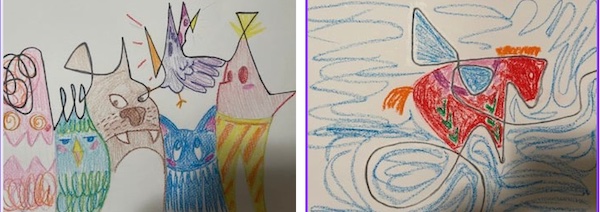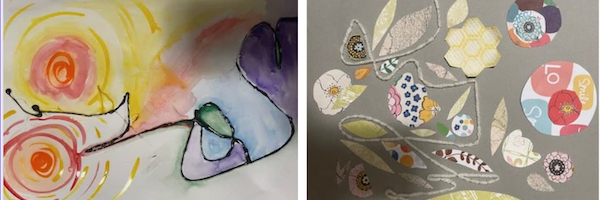SUBJECTS
GRADE
Show Results
Walk The Line

Lesson Summary
- Using the books Fall in Line, Holden! and/or When We Were Alone, students will create a collaborative visual art piece.
Lesson Plan and Procedure
Lesson Key Facts
- Grade(s): K, 1, 2, 3, 4, 5, 6
- Subject(s): English Language Arts, Health, Social Studies, Visual Arts, Native American
- Duration of lesson: 15-60 minutes
- Author(s): Karilee Park
Teacher Instructions
You may choose to use both books for this lesson, or just one. If using only one book, Fall in Line, Holden! is suggested for younger grades and When We Were Alone for older.
The art project is done in two main steps, and is meant to be done in partners. Each variation can be adapted for the appropriate grade level, but they are presented here for specific ages.
Lesson
This collaborative art project is intended to honor Native American children throughout history and in the present day. It is a reminder that, while we cannot control the actions of others, we have the power to control ourselves, our reactions, and our future choices. The hope is that each participant will gain insight into what they already do and what they can change to make the best out of the worst situations.
Art has always been used to strengthen cultural ties, and to establish connections between all people. For this reason, art can be a powerful educational tool to help students connect with the characters in Fall in Line, Holden! and When We Were Alone, with their classmates, and with others in their schools and communities. There is power in expressing personal creativity through art. Participation in the arts can be a healing experience. It is a way to express strong feelings in a safe way without needing to find words to express those feelings. You can find beauty in hard times and personal strength in challenges.
Fall in Line, Holden!
Read Fall in Line, Holden! and discuss main points with the students. Perhaps this is a focus on how Holden was able to keep his imagination and creativity, or what made him special and unique. Here are some possible questions to ask:
Teacher:
- Why was it important for everyone to fall out of line?
- Why was Holden’s imagination so important?
- Is it ok to be different?
- How are you different?
When We Were Alone
Read When We Were Alone and ask the children what they noticed.
Teacher:
- Why did Nôkom like to be alone when she was a child?
- When was she alone?
- Was she ever really alone?
- Do you have a friend that you like to be “alone” with? Why?
- What would do in Nôkom’s situation?
- Why were Holden and Nôkom told to be just like everybody else? (If reading both
stories).
Teacher: Just like Holden and/or Nôkom found ways to transform their situations and keep their unique culture, language, and perspective, we are going to create a piece of art with a partner that will help us do the same.
Note: the project will be done in two parts—creating a scribble and transforming someone else’s scribble. Here are some examples of finished projects:


Hand each student a piece of paper and have them do one of the following actions.
Note: The following links contain instructions for this step according to action and grade. They are only for the FIRST step of the process. These slides are meant for teachers only, and are not meant to be shown in class:
Draw (K-2)
Glue (2-6)
Stitch (5-6)
Teacher: Now that we have our scribbles, I want to know how you felt about making your own line with all the same tools as everybody else. What was challenging about it? Did you like it? Why or why not?
One thing we noticed in “Fall in Line, Holden!” and/or “When We Were Alone” is that the characters transformed their situations. Each of you is going to trade your scribble with a partner to transform the other scribble. I want you to remember that your partner worked hard on their scribble, so do not change it or cover it up! Be respectful and honor their work by using their scribble as an inspiration. While working on this next part, I want you to think of the things that are important to you. What makes you different? Who do you like to share those things with? Just as Holden and his friends who fell out of line gained color with their imaginations, and just like Nôkom loved to wear bright colors, we are going to use colors to transform our scribbles into something extraordinary!
Note: The following links contain instructions for this step according to grade. While any combination of techniques can be used or adjusted to any grade level, specific examples are given to help with the process. Students may create representational or abstract art for their transformation. These slides can be used in class with students.
Crayon/Watercolor (K-2)
Oil Pastel (2-6)
Collage (5-6)
Teacher: How did it feel to transform your partner’s scribble? Does your partner like your work? Explain (or write) what things you were expressing with the artwork and what it means to you. Why would it be important for us to work with our partner instead of on our own?
Learning Objectives
- Collaboration through trading work
- Transforming something into something else
- Following instructions step by step
Utah State Board of Education Standards
This lesson can be used to meet standards in many grades and subject areas. We will highlight one grade’s standards to give an example of application.
Grade 3 Visual Art
- Standard 3.V.CR.1: Elaborate on an imaginative idea and apply knowledge of available resources, tools, and technologies to investigate personal ideas through the art-making process.
- Standard 3.V.CR.2: Create a personally satisfying artwork using a variety of artistic processes and materials.
- Standard 3.V.R.2: Analyze use of media to create subject matter, characteristics of form and mood.
Grade 3 Social Studies
- Standard 3.2.3: Define their own cultures or the cultures of their communities (for example, art, music, food, dance, system of writing, architecture, government to which they are regularly exposed or of which they are part).
- Standard 3.2.4: Evaluate how their community has changed over time (for example, economic interdependence, changes to the environment).
- Standard 3.3.4: Describe some of the civic roles that people fulfill within their community, and explain the reasons why people choose to serve in those roles and how they benefit the community.
Grade 3 Health
- Standard 3.MEH.1: Identify healthy strategies individuals may use to cope with disappointment, grief, sadness, and loss, including talking with a trusted adult.
Grade 3 English Language Arts
- Standard 3.SL.1: Participate effectively in a range of conversations and collaborations, using age-appropriate vocabulary, on topics, texts, and issues.
a. Respectfully acknowledge and respond to others' perspectives during discussions.
b. Recognize that comments and claims may include two perspectives.
c. Participate in conversations by asking questions, acknowledging new
information, connecting responses, and keeping the discussion on topic. - Standard 3.W.2: (optional) Write informative/explanatory pieces to examine a topic that conveys ideas and information clearly, link ideas within categories of information using words and phrases, and provide a concluding statement.
a. Introduce and develop a topic using facts, definitions, details, and group
related information and graphics together.
b. Write, produce, and expand simple, compound, and complex sentences.
c. Use appropriate conventions when writing including text cohesion, sentence
structure, and phrasing.
Equipment and Materials Needed
- Fall in Line, Holden! by Daniel W. Vandever
- When We Were Alone by David A. Robertson
- Paper (like card stock)
- Scissors
- Glue
- Pencil
- Crayons/colored pencils/markers/oil or chalk pastels
- Watercolor paint
- Variety of colored and patterned paper (for collage)
- Embroidery floss
- Needles
- Yarn
- Cork or foam board
Additional Resources
This lesson was created thanks to a grant from the National Endowment for the Arts and the Utah Division of Arts & Museums.
- Fall in Line, Holden! reading by the author here
- When We Were Alone reading by author here and a learning guide here
The following lessons also focus on books by indigenous authors that highlight “Every Child Matters”:
- Fall in Line, Holden: Creative Dance
- Fall in Line, Holden: Creative Vocal Play
- When We Were Alone: Every Child Matters
Image References
Images 1-5: Karilee Park

www.education.byu.edu/arts/lessons
 Download
Download